ICSE Biology Previous Year Question Papers 2017 Solved for Class 10
General Instructions:
- Answers to this Paper must be written on the paper provided separately.
- You will not be allowed to write during the first 15 minutes.
- This time is to be spent in reading the Question Paper.
- The time given at the head of this paper is the time allowed for writing the answers.
- Attempt all questions from Section I and any four questions from Section II. The intended marks for questions or parts of questions are given in brackets [ ].
Section -1 [40 Marks]
(Attempt All questions from this section)
Question 1.
(a) Name the following : [5]
(i) The process by which root hairs absorb water from the soil.
(ii) The organ which produces urea.
(iii) The kind of lens required to correct Myopia.
(iv) The pituitary hormone which stimulates contraction of uterus during child birth.
(v) The international health organisation which educates people in accident prevention.
Answer:
(i) Osmosis
(ii) Liver
(iii) Concave lens
(iv) Oxytocin
(v) Red cross
(b) Choose the correct answer from each of the four options given below: [5]
(i) The prime source of chlorofluorocarbons is :
A. Vehicular emissions
B. Industrial effluents
C. Domestic sewage
D. Refrigeration equipments
Answer:
D. Refrigeration equipments
(ii) Penicillin obtained from a fungus is :
A. Antibiotic
B. Antiseptic
C. Antibody
D. Antiserum
Answer:
A. Antibiotic
(iii) Marine fish when placed in tap water bursts because of:
A. Endosmosis
B. Exosmosis
C. Diffusion
D. Plasmolysis
Answer:
A. Endosmosis
(iv) Surgical method of sterilization in a woman involves cutting and tying of:
A. Ureter
B. Uterus
C Urethra
D. Oviduct
Answer:
D. Oviduct
(v) Synthesis phase in the cell cycle is called so, because of the synthesis of more:
A. RNA
B. RNA and proteins
C. DNA
D. Glucose
Answer:
C. DNA
(c) The statements given below are incorrect. Rewrite the correct statement by changing the underlined words of the statements. [5]
(i) The Graafian follicle, after ovulation turns into a hormone producing tissue called Corpus callosum.
(ii) Deafness is caused due to the rupturing of the Pinna.
(iii) Gyri and Sulci are the folds of Cerebellum.
(iv) Free movement of solutes in and out of the cell takes place across the cell membrane.
(v) The solvent used to dissolve the chlorophyll pigments while testing a leaf for starch is Soda lime.
Answer:
(i) The Graafian follicle, after ovulation turns into a hormone producing tissue called Corpus luteum.
(ii) Deafness is caused due to rupturing of the eardrum/tympanum.
(iii) Gyri and Sulci are the folds of Cerebrum.
(iv) Free movement of solute in and out of the cell takes place across the cell wall.
(v) The solvent used to dissolve the chlorophyll pigments while testing a leaf for starch is Methylated spirit / Alcohol.
(d) Given below are sets of five terms each. Rewrite the terms in correct order in a logical sequence. [5]
Example : Large intestine, Stomach, Mouth, Small intestine, Oesophagus.
Answer : Mouth → Oesophagus → Stomach → Small intestine → Large intestine.
(i) Fibrin, Platelets, Thromboplastin, Fibrinogen, Thrombin.
(ii) Cochlea, Malleus, Pinna, Stapes, Incus.
(iii) Receptor, Spinal cord, Effector, Motor neuron, Sensory neuron.
(iv) Uterus, Parturition, Fertilisation, Gestation, Implantation.
(v) Caterpillar, Snake, Owl, Frog, Green leaves.
Answer:
(i) Platelets, Thromboplastin, Thrombin, Fibrinogen, Fibrin.
(ii) Pinna, Malleus, Incus, Stapes, Cochlea.
(iii) Receptor, Sensory neuron, Spinal cord, Motor neuron, Effector.
(iv) Fertilisation, Uterus, Implantation, Gestation, Parturition.
(v) Green leaves, Catterpillar, Frog, Snake, Owl.
(e) Choose the ODD one out of the following terms given and name the CATEGORY to which the others belong : [5]
(i) Aqueous humour, Vitreous humour, Iris, Central canal
(ii) Formalin, Iodine, DDT, Lime
(iii) ACTH, TSH, ADH, FSH ‘
(iv) Phosphate, RNA, Sugar, Nitrogenous base
(v) Bile, Urea, Uric add, Ammonia
Answer:

(f) Given below are groups of terms. In each group the first pair indicates the relationship between the two terms. Rewrite and complete the second pair on a similar basis.
Example: Oxygen: Inspiration:: Carbon dioxide: Expiration [5]
(i) Eye: Optic nerve:: Ear :
(ii) Cytoplasm : Cytokinesis:: Nucleus :
(iii) TT: Homozygous:: Tt:
(iv) Foetus: Amnion:: Heart:
(v) Adenine: Thymine:: Cytosine :
Answer:
(i) Eye: Optic nerve:: Ear: Auditory nerve
(ii) Cytoplasm : Cytokinesis:: Nucleus: Karyokinesis
(iii) TT : Homozygous:: Tt: Heterozygous
(iv) Foetus: Amnion:: Heart: Pericardium
(v) Adenine: Thymine:: Cytosine: Guanine
(g) Match the items given in Column A with the most appropriate ones in Column B and rewrite the correct matching pairs.

Answer:

(h) The diagram given below represents the location and structure of an endocrine gland. Study the same and answer the questions that follow:

Answer:
(i) Thyroid gland
(ii) Thyroxine
(iii) Iodine
(iv) Cretinism
(v) Exophthalmic goitre / Grave’s disease.
Section – II [40 Marks]
(Attempt any four questions from this Section)
Question 2.
(a) Study the diagram given below which represents a stage during the mitotic cell division and answer the questions that follow: [5]

(i) Identify the stage giving suitable reasons.
(ii) Name the parts numbered 1 and 2.
(iii) What is the technical term for the division of nucleus?
(iv) Mention the stage that comes before the stage shown in the diagram. Draw a neat labelled diagram of the stage mentioned.
(v) Which is the cell division that results in half the number of chromosomes in daughter cells?
Answer:

(i) The stage is Telophase The reason is the nucleus and nucleolus reappears and spindle fibres disappeard.
(ii)
- Centromere
- Nuclear membrane/Nucleus
(iii) Karyokinesis
(iv) Anaphase
(v) Meiosis
(b) Differentiate between the following pairs on the basis of what is mentioned in brackets: [5]
(i) Active Transport and Diffusion [Significance in plants]
(ii) Demography and Population density [Definition]
(iii) Antibiotic and Antibody [Source]
(iv) Renal cortex and Renal medulla [Parts of the nephrons present]
(v) NADP and ATP [Expand the abbreviation]
Answer:
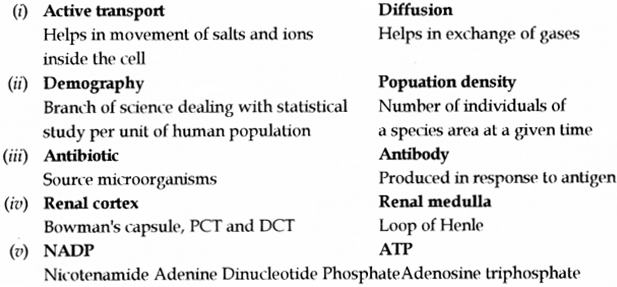
Question 3.
(a) The diagram given below represents a plant cell after being placed in a strong sugar solution. Study the diagram and answer the questions that follow: [5]
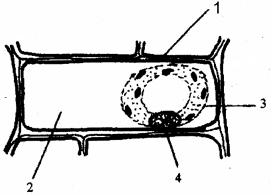
(i) What is the state of the cell shown in the diagram?
(ii) Name the structure that acts as a selectively permeable membrane.
(iii) Label the parts numbered 1 to 4 in the diagram.
(iv) How can the above cell be brought back to its original condition? Mention the scientific term for the recovery of the cell.
(v) State any two features of the above plant cell which is not present in animal cells.
Answer:
(i) The state of the cell is Plasmolysed.
(ii) Cell membrane.
(iii)
- Cell wall
- Strong sugar solution
- Cell membrane
- Nucleus.
(iv) By putting it in hypotonic solution/water.
The scientific term for the recovery of the cell is deplasmolysis.
(v) (i) Cell wall
(ii) Vacuole.
(b) Given below is a representation of a kind of pollution. Study the same and answer the questions that follow : [5]
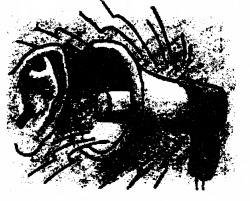
(i) Name the kind of pollution.
(ii) List any three common sources of this pollution.
(iii) Mention three harmful effects of this pollution on human health.
(iv) Explain the term ‘Pollutant’.
(v) Name two soil pollutants.
Answer:
(i) Noise pollution.
(ii) Automobiles and road transport, jet aeroplanes, loudspeakers, radio and musical hands.
(iii) Nervous irritability, damage of eardrum, disturbs piece of mind.
(iv) The agents that cause pollution is called Pollutant.
(v) Pesticides, Styrofoam, Chemical fertilizers, domestic and industrial wastes.
Question 4.
(a) The diagrams given below represent the relationship between a mouse and a physiological process that occurs in green plants. Study the diagrams and answer the questions that follow: [5]
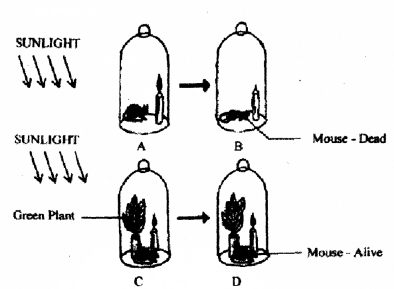
(i) Name the physiological process occurring, in the green plant that has kept the mouse alive.
(ii) Explain the physiological process mentioned above.
(iii) Why did the mouse die in bell jar B?
(iv) What is the significance of the process as stated in (i) for life on earth?
(v) Represent the above mentioned physiological process in the form of a chemical equation.
Answer:
(i) photosynthesis.
(ii) Photosynthesis is the process by which h green plants in the presence of sunlight and chlorophyll prepare food in the form of carbohydrates using carbon dioxide and water.
(iii) Mouse died in hell jar B because the source of oxygen i.e, the green plant was missing and the oxygen present in the bell jar was utilized in burning of candle.
(iv) Photosynthesis provides food and balances the oxygen and carbon cycle in the atmosphere.
Chlorophyll
(v)
![]()
(b) Mention the exact location of the following: [5]
(i) Prostate gland
(ii) Myelin sheath
(iii) Islets of Langerhans
(iv) Semi-circular canals
(v) Eustac hian tube.
Answer:
(i) Inferior to urinary bladder encircling urethra.
(ii) Inner sheath around the axon of a neuron.
(iii) In the pancreas.
(iv) Internal ear above utriculus.
(v) Between middle ear and pharynx.
Question 5.
(a) The diagram shown below Ls the longitudinal section of a testis of man. Study it carefully and answer the question that follow : [5]
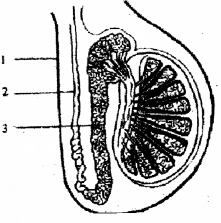
(i) Label the parts numbered 1 to 3 in the diagram.
(ii) In which part of the testis are the sperms produced?
(iii) State the functions of the parts labelled 1 and 3 in the diagram.
(iv) Name the cells that. secrete Testosterone.
(v) Draw a neat, labelled diagram of a sperm.
Answer:
(i)
- Scrotum
- Sperm duct/vasa deferens
- Epididymis
(ii) Seminiferous tubules.
(iii) Scrotum: Brings the temperature 2 – 3 °C for the maturation of sperms.
Epididymis: Store the sperms and help in their maturity.
(iv) Ley dig’s cells.
(v)

(b) Give biological reasons for the following statements: [5]
(i) Some women have facial hair like beard and moustache.
(ii) Cutting of trees should be discouraged.
(iii) In some xerophytes leaves are modified into spines.
(iv) There is frequent ruination in winter than in summer.
(v) The left ventricle of the heart has a thicker wall than the right ventricle.
Answer :
(i) Some women have facial hair like beard and moustache because of adrenal virilism, in which excess secretion of adrenal androgen takes place and causes this male effect in females.
(ii) Cutting of tree should be discouraged because it would lead to less utilization of Co2 in photosynthesis due to which rise in Co2 will lead to greater retention of solar radiation in the atmosphere causing global warming.
(iii) Since xerophytes grow in dry conditions where water is less, in order to reduce transpiration their leaves are modified into spines.
(iv) In winter, there is no sweating and most of the excess water is eliminated from body in the form of urine.
(v) It has to push the blood to the remotest parts of the body such as toes of the feet so the left ventricle of the heart has thicker wall.
Question 6.
(a) The diagram given below represents a section of the human heart. Answer the questions that follow: [5]

(i) Which parts of heart are in the diastolic phase? Give a reason to support your answer.
(ii) Label the parts numbered 1 and 2 in the diagram. What type of blood flows through them?
(iii) What causes the heart sounds ‘LUBB’ and ‘DUP’?
(iv) Name the blood vessels that supply oxygenated blood to the heart muscles.
(v) Draw neat labelled diagrams of a cross-section of an artery and a vein.
Answer:
(i) Ventricles, as the blood is flowing towards ventricle since tricuspid and bicuspid valves are open.
(ii)
- Pulmonary artery
- Left pulmonary veins.
(iii) The LUBB sound is caused due to the closure of the auriculo-ventricular valves while DUP sound is caused due to the closure of the semilunar valve.
(iv) Coronory arteries supply oxygenated blood to the heart muscles.

(b) Give appropriate biological/technical terms for the following: [5]
- The type of immunity that exists in our body due to our genetic makeup.
- The suppressed allele of a gene.
- The accessory gland in human males whose secretion activates the sperms.
- An apparatus that measures the rate of water uptake in a cut shoot due to transpiration.
- The kind of twins formed from two fertilised eggs.
- A pair of corresponding chromosomes of the same size and shape, one from each parent.
- The mild chemical substance which when applied on the body kills germs.
- The type of waste generated in hospitals and pathological laboratories.
- The antiseptic substance in tears.
- Cellular components of blood containing haemoglobin.
Answer:
- Innate/Inborn immunity
- Recessive
- Seminal vesicles
- Ganong’s potometer
- Nomn identical/Fraternal
- Homologous chromostone
- Antiseptic
- Biomedical Wastes
- Lysozymes
- Red blood cells / Red blood corpuscles
Question 7.
(a) In a homozygous pea plant, axial flowers (A) are dominant over terminal flowers (a). [5]
(i) What is the phenotype and genotype of the Fx generation if a plant bearing pure axial flowers is crossed with a plant bearing pure terminal flowers?
(ii) Draw a Punnett square board to show the gametes and offsprings when both the parent plants are heterozygous for axial flowers.
(iii) What is the phenotypic ratio and genotypic ratio of the above cross shown in (it)?
(iv) State Mendel’s Law of Dominance.
(v) Name two genetic disorders commonly seen in human males.
Answer:
(i) The phenotype of F | generation is all plants grow into axial flowers. The genotype of Fi generation is all plants are Aa.
(ii)

(iii) Phenotypic ratio : 3: 1
Genotypic ratio : 1:2:1
(iv) In heterozygous condition, out of the two alleles, one expresses itself morphologically and the other remains unexpressed. The allele which expresses itself phenotypically is called dominant and the other which remains unexpressed is called recessive.
(v) Colourblindness and Haemophilia.
(b) The diagram given below is an external view of the human brain. Study the same and answer the questions that follow : [5]
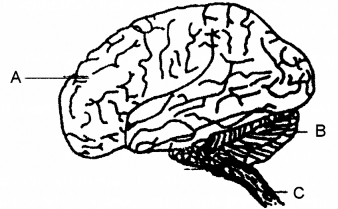
(i) Name the parts labelled A, B and C in the diagram.
(iii) What are the structural and functional units of the brain? How are the parts of these units arranged in A and C?
(iv) Mention the collective term for the membranes covering the brain.
(v) What is the function of Cerebrospinal fluid?
Answer:
(i) A. Cerebrum
B. Cerebellum
C. Spinal cord
(ii) A. It is the seat of memory, will power, emotions, experience, intelligence and controls all voluntary actions of the body.
B. Maintains balance of the body.
(iii) Neuron/Nerve cell.
In A grey matter is outside and white matter is inside while in C grey matter is inside and white matter is outside.
(iv) Meninges.
(v) It serves as shock absorbing medium. Protects brain and the rest of CNS against jerk and jolts. It maintains constant pressure in and around the brain.
